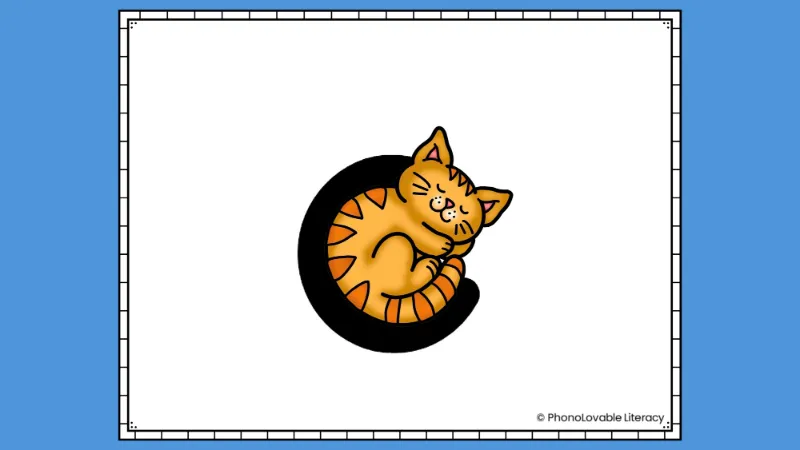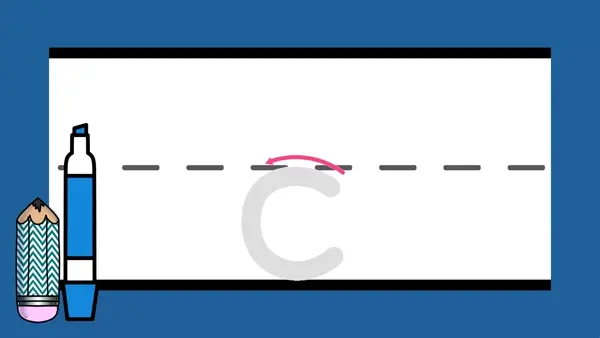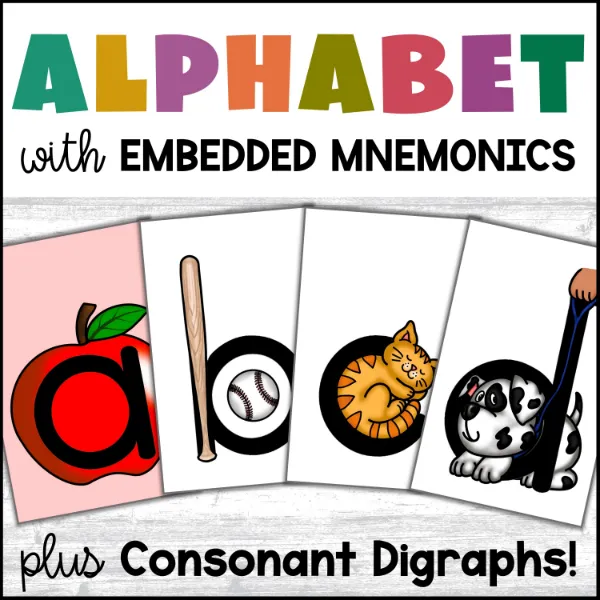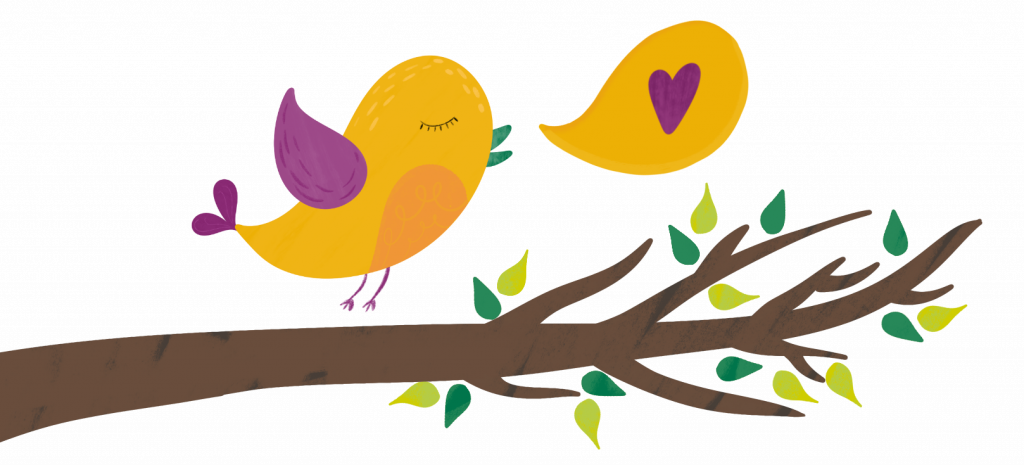Are you looking for a simple, yet effective approach for introducing the letter c to preschoolers and kinders?
I used to follow a routine that went something like this:
“Let’s meet the letter c (holding up the printed letter on a card). C says /k/ (hard c sound), as in cat (showing a picture of a cat underneath the letter). Repeat after me, C, cat, /k/”.
I did this for about a decade and most of my students eventually learned to read just fine. But it seemed like it took way too long for some kids to acquire or retain the letter sounds I taught. This was especially the case when I transitioned from general education to special education and then intervention.
After years of training in structured literacy and trying different approaches with my high-needs students, I now have a strong preference for the routine I’ll share below.
I love it because it’s easy to learn and implement, and it has consistently resulted in my students successfully learning letter sounds much more quickly than before.
So here’s my routine and a bit about why it works. If there’s something new for you here, I hope you’ll try it and see wonderful results!
Routine for Introducing the Letter C and Its Hard Sound
You can watch this video to get an idea of the entire routine. You can even play it for your students!
Start with speech.
Why?
Since our brains are naturally wired for oral (rather than printed) language, beginning with sounds as oppose to letters gives our students a natural starting point for learning to read and write.
It’s also more fun for kids. Starting my lesson by asking my kids to repeat relatable and familiar words like cats and cookies, while also showing photographs of those cuddly cats and mouth-watering cookies, captures and holds their attention more than showing them a card of the printed letter c.

How?
Say 3-6 words that begin with the letter c, such as cupcakes, cookies, caterpillar, corn, car, and cat. Ask children to repeat each word after you say it. Showing an image of each word can be especially beneficial for students with limited English vocabulary. Tell students that all of these words begin with the sound /k/. This is the “hard sound” of the letter c (as opposed to the “soft sound” which sounds like /s/ like cent or city).
Draw attention to your mouth when you make the /k/ hard c sound.
Why?
Simply put, drawing our kids’ attention to how our mouths look and feel while producing the sound helps make an abstract concept more concrete. This adds an additional multisensory component to our approach, which is beneficial for many of our students.

How?
Ask students to notice what their mouth is doing to make the sound /k/. If you teach a small group, hold up a mirror to let students look at their own mouths. If you have a larger group, simply model with your own mouth and/or show a sound articulation card (mouth pic).
To make this sound, you need to press the back of your tongue to the back of your mouth. Model this for your students and/or show a “mouth pic” card such as the one above. Tell students that they don’t need to open their mouths this wide, but it is helpful to introduce the sound this way so children can see the elevation of the base of the tongue. This is hard to see with the jaw less open. A slight amount of air comes out of your mouth. Ask students to make the sound themselves and feel the air come out.
Introduce the printed letter with an EMBEDDED mnemonic.
Why?
Using pictures of relatable objects for keywords makes sense, as students will more likely remember them. What makes even more sense is to have that picture embedded inside the letter, as opposed to next to, above, or below the letter. Research back this up as well. Using embedded mnemonics is the most effective and efficient way for students to acquire AND retain letter sounds. The pictures provide powerful memory aids in the beginning of instruction and are faded out as students master each sound.

How?
Here is where you’ll first show your students the actual letter. But not just a plain letter, an embedded letter. The image of a keyword such as a cat curled up inside the letter helps strengthen the connection between letter and sound.
Model and practice how to write the letter.
Why?
There’s a popular quote from Pam Allyn: “Reading is like breathing in, and writing is like breathing out.” Reading is the input; writing is the output. I know she was referring to much more advanced forms of reading and writing than letter sounds, but that phrase perfectly sums up how much reading and writing need each other, even in the early stages. We teach letter sounds so that students may not only decode new words, but learn to write them as well.

How?
I prefer to keep my letter formation language simple. You may have different wording from a program you’ve used, or you may wish to change up how you say this, but here’s what I say as I model how to write the lowercase letter c.
“Curve up to the middle line, curve down to the bottom line.” I model with my hand in the air and/or show an animated slide on my computer (in small group) or smart TV (in whole group). Ask students to follow along with their fingers in the air. If children are seated at desks, ask them to finger-write it on the desk.
If you are tutoring or have one-on-one instruction, you can also do this in a tray of sand or beads. Shaving cream is also an option if you have a thick towel nearby to clean up the mess! None of those options are necessary though. Sky or desk writing is plenty effective!
I usually have students practice without a writing utensil a few times before I ask them to write with a dry-erase marker or pencil. This is just so I can make sure they’ve got the movements down or at least the letter-formation language before they put it on paper.
Research-Aligned Alphabet Resources
Need easy-to-use resources to implement the steps above?
Here are my recommendations for introducing the letter c and other letters to your preschoolers or kindergarten students:
Initial Sound Slides: These no-prep slides introduce each letter sound in the most effective and efficient way. With each click, you will show images of interesting photographs containing the beginning sound, a photo of a real kid making the sound along with a keyword image, the letter with an embedded mnemonic image, and lastly, an animated letter formation slide (one for uppercase and one for lowercase letters).
Mnemonic Alphabet Articulation Mouth Cards | Alphabet Posters with Real Pictures: If you prefer a paper option or don’t have access to digital resources, you may like these printable, 1-page posters of mouth pics along with the embedded mnemonic letters. It’s also a nice way to display the alphabet if you have classroom wall space.
Alphabet Picture Cards with Embedded Mnemonics: This set of printable pages comes with embedded letter cards in two sizes. Teach phonemes for 21 consonants, 5 short vowels, AND consonant digraphs WH, TH, SH, CH, and CK.

Get a free set of small embedded letter cards when you join us in our newsletter community!
Looking for an “everything bundle” of embedded letter resources, including digital slides, letter cards, worksheets, games, and more? Save nearly 50% and get all 12 resources. Get your students quickly and effectively mastering letter sounds so they can begin the even more exciting discovery of how to read and write words!
Sources:
Ehri, L. C., Deffner, N. D., & Wilce, L. S. (1984). Pictorial mnemonics for phonics. Journal of Educational Psychology, 76(5), 880–893. https://doi.org/10.1037/0022-0663.76.5.880
Ehri, L. C. (2013). Orthographic Mapping in the Acquisition of Sight Word Reading, Spelling Memory, and Vocabulary Learning. Scientific Studies of Reading, 18(1), 5–21. https://doi.org/10.1080/10888438.2013.819356
Ehri, L.C. (2022). What Teachers Need to Know and Do to Teach Letter–Sounds, Phonemic Awareness, Word Reading, and Phonics. The Reading Teacher, 76(1), 53-61. https://doi.org/10.1002/trtr.2095
McNamara, G. (2012). The effectiveness of embedded picture mnemonic alphabet cards on letter recognition and letter sound knowledge. Theses and Dissertations. 302. https://rdw.rowan.edu/etd/302
Shmidman, A., & Ehri, L. (2010). Embedded Picture Mnemonics to Learn Letters. Scientific Studies of Reading, 14(2), 159–182. https://doi.org/10.1080/10888430903117492

